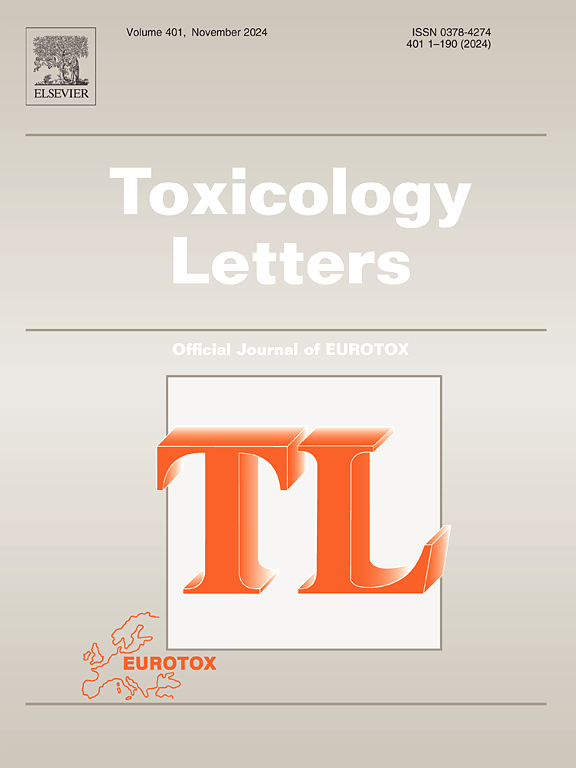Involvement of mitochondrial dysfunction and oxidative stress in the nephrotoxicity induced by high-fat diet in Sprague-Dawley rats
IF 2.9
3区 医学
Q2 TOXICOLOGY
引用次数: 0
Abstract
The prevalence of obesity-associated kidney injury has increased, yet the precise extent of the injury and its underlying mechanisms remain unclear. This study used a Sprague-Dawley (SD) rat model to simulate human exposure scenarios, with the objective of investigating the involvement of mitochondria in obesity-induced renal toxicity. Biochemical analysis revealed significant increases in serum creatinine, cystatin C, urinary protein, urinary microalbumin, and urinary α1-microglobulin levels in rats fed a high-fat diet, indicating a notable decline in glomerular filtration function. Histopathological examination showed mild to moderate degeneration in renal tubular epithelial cells, slight glomerular enlargement, fusion and disappearance of pedunculated cell, and decreased electron density of mitochondrial matrix and cristae, indicating the impaired filtration function of kidney. Furthermore, the study found reduced mitochondrial membrane potential and superoxide dismutase (SOD) levels, along with increased malondialdehyde (MDA) levels, signifying elevated mitochondrial oxidative stress in the kidneys of high-fat diet-fed rats. Additionally, a decrease in the number of mitochondrial uncoupling protein-2 (UCP-2) and proliferator-activated receptor gamma coactivator 1-alpha (PGC1α)-positive cells, as well as reduced protein expression levels in the mitochondria, suggests a reduced renal mitochondrial resistance to oxidative stress. Collectively, these findings indicate that a high-fat diet triggers abnormalities in both renal filtration and structural functionality in SD rats. The observed reduction in renal mitochondrial density and the elevation in oxidative stress levels could potentially serve as underlying mechanisms.
Sprague-Dawley大鼠高脂饮食所致肾毒性中线粒体功能障碍和氧化应激的参与。
肥胖相关肾损伤的患病率有所增加,但损伤的确切程度及其潜在机制尚不清楚。本研究使用Sprague-Dawley (SD)大鼠模型模拟人类暴露情景,目的是研究线粒体在肥胖诱导的肾毒性中的作用。生化分析显示,饲喂高脂饲料的大鼠血清肌酐、胱抑素C、尿蛋白、尿微量白蛋白和尿α1微球蛋白水平显著升高,肾小球滤过功能明显下降。组织病理学检查显示肾小管上皮细胞轻至中度变性,肾小球轻微增大,带梗细胞融合消失,线粒体基质和嵴电子密度降低,提示肾脏滤过功能受损。此外,研究发现线粒体膜电位和超氧化物歧化酶(SOD)水平降低,丙二醛(MDA)水平升高,表明高脂肪饮食喂养的大鼠肾脏线粒体氧化应激升高。此外,线粒体增殖因子激活受体γ辅助激活因子1- α (PGC1α)和解偶联蛋白2 (UCP-2)阳性细胞数量的减少,以及线粒体中蛋白质表达水平的降低,表明肾脏线粒体对氧化应激的抵抗能力降低。总之,这些发现表明,高脂肪饮食会引发SD大鼠肾脏滤过和结构功能的异常。观察到的肾线粒体密度降低和氧化应激水平升高可能是潜在的机制。
本文章由计算机程序翻译,如有差异,请以英文原文为准。
求助全文
约1分钟内获得全文
求助全文
来源期刊

Toxicology letters
医学-毒理学
CiteScore
7.10
自引率
2.90%
发文量
897
审稿时长
33 days
期刊介绍:
An international journal for the rapid publication of novel reports on a range of aspects of toxicology, especially mechanisms of toxicity.
 求助内容:
求助内容: 应助结果提醒方式:
应助结果提醒方式:


